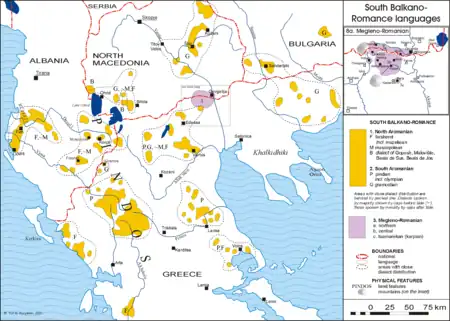
The Aromanian dialects (Aromanian: dialecti or grairi/graire) are the distinct dialects of the Aromanian language. The Aromanians are an ethnic group composed of several subgroups differentiated from each other by, among other things, the dialect they speak. The most important groups are the Pindeans, Gramosteans, Farsherots and Graboveans, each with their respective dialect.[1] The Graboveans and their dialect are referred to by some authors as Moscopoleans[2] and Moscopolean.[3] The Aromanians of the villages of Gopeš (Gopish) and Malovište (Mulovishti) in North Macedonia also have their own distinctive dialect.[4] A few scholars also add the Olympian dialect spoken in Thessaly, Greece,[5] but the majority view is that Olympian is part of Pindean.[6]
The Codex Dimonie, a collection of historical Aromanian-language religious texts translated from Greek, features several characteristics of the Grabovean dialect.[7] In his dictionary of five languages, including Aromanian, the historical Aromanian linguist Nicolae Ianovici made use of the endonym ramanu for "Aromanian". This is typical of the Farsherot dialect, suggesting that Ianovici belonged to the subgroup of Farsherot Aromanians.[8]
Main subdivisions
According to studies done since the start of 20th century, the Aromanian of Gramosteans, Farsherots and Graboveans comprise a northern or northwestern group of the language while the Pindean and Olympian dialects belong to a southern variety. However, these two major groups often overlap and intermingle in some smaller Aromanian-speaking regions. The main differences between the northern and southern dialects are:[9]
- The spread of syncope. Southern dialects make use of syncope much more frequently. Some forms seen in Southern varieties are exclusive, for example mcari (standard mãcari/mâcari[10]) or altsari (standard anãltsari[11])
- Unstressed /ɛ/ pronounced as /i/. Southern dialects often pronounce unstressed /ɛ/, in particular in final position, as /i/. For example, for the northern carte, feate, seate, the corresponding southern words are carti, feati, seati.
- Voicing of plosive consonants ⟨c⟩, ⟨p⟩ and ⟨t⟩ as ⟨g⟩, ⟨b⟩ and ⟨d⟩ respectively when preceded by nasal consonants. Thus, alantu becomes alandu and mplai becomes mblai in southern dialects.
- Use of va sã vs. va to form future tense. Northern dialects employ constructions of the form: va sã, vu se, va s- (va s-cãntu) while southern dialects use va, vai (vai cãntu).
- Replacement of possessive pronouns with enclitic personal pronouns in the southern dialects, for example hoarã-lã (literally "village-them", meaning "their village")
See also
References
Citations
- ↑ Nevaci 2013, p. 103.
- ↑ Saramandu & Nevaci 2017, p. 21.
- ↑ Saramandu & Nevaci 2017, p. 20.
- ↑ Nevaci 2013, p. 115.
- ↑ Vrabie, Emil (2000). An English-Aromanian (Macedo-Romanian) Dictionary. Romance Monographs. p. 22. ISBN 1-889441-06-6.
- ↑ Saramandu, Nicolae; Nevaci, Manuela (2020). "Atlasul lingvistic al dialectului aromân (ALAR)" (PDF). lingv.ro. p. 31. Retrieved 31 October 2023.
- ↑ Saramandu & Nevaci 2017, p. 19.
- ↑ Lascu 2017, p. 14.
- ↑ Capidan, Theodor. "Aromânii. Dialectul aromân (1932)". vdocumente.com (in Romanian). pp. 193–196. Retrieved 2 December 2023.
- ↑ "Dictsiunar". www.dixionline.net. Retrieved 2 December 2023.
- ↑ "Dictsiunar". www.dixionline.net. Retrieved 2 December 2023.
Bibliography
- Lascu, Stoica (2017). "Intelectuali transilvăneni, moldoveni și "aurelieni" despre românii din Balcani (anii '30-'40 ai secolului al XIX-lea" (PDF). Annals of the Academy of Romanian Scientists: Series on History and Archaeology Sciences (in Romanian). 9 (2): 5–27. ISSN 2067-5682.
- Nevaci, Manuela (2013). "Graiurile aromânești din Peninsula Balcanică. Situația actuală". Fonetică și dialectologie (in Romanian). 32: 103–127.
- Saramandu, Nicolae; Nevaci, Manuela (2017). "The first Aromanian literature: the teaching writings (Theodor Cavallioti, Daniil Moscopolean, Constantin Ucuta)" (PDF). Studia Albanica. 54 (1): 11–27.
